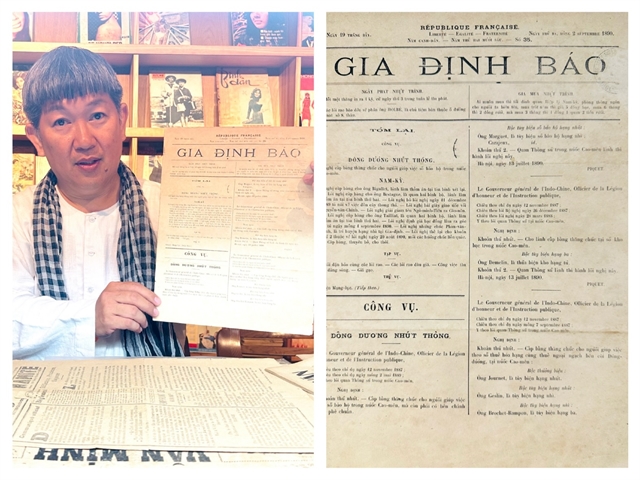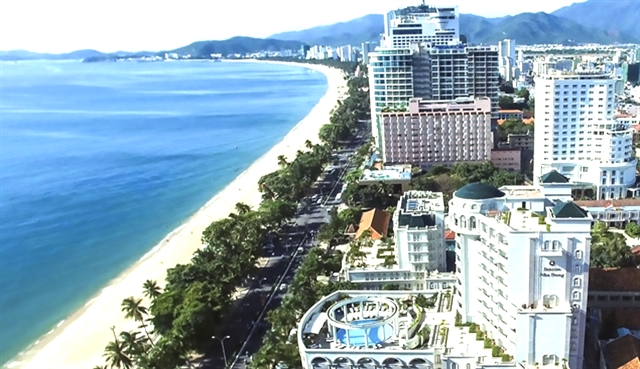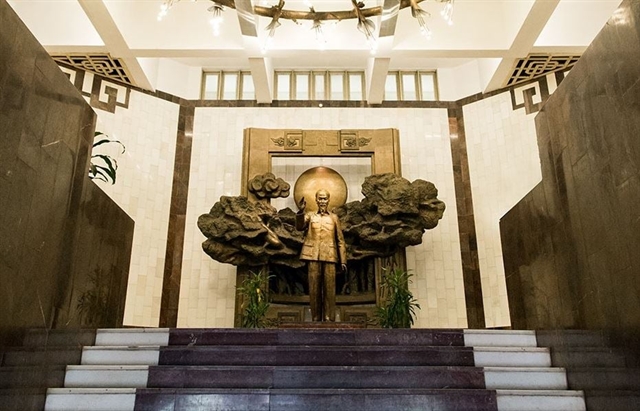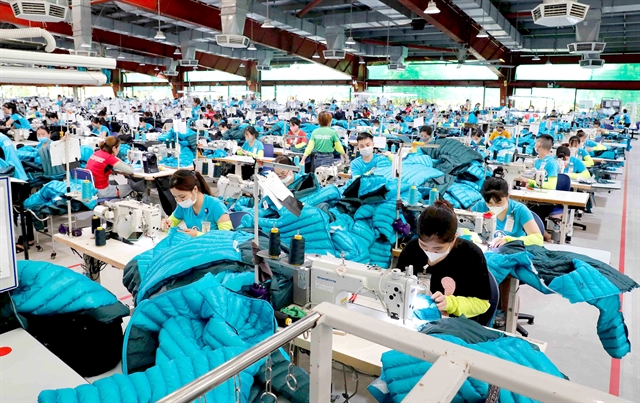 Society
Society

Nguyễn Diệp
 |
| Huỳnh Minh Hiệp of HCM City is a collector who has some 1,000 newspapers and journals published in the last century or so. — VNS Photo Nguyễn Diệp |
HCM CITY — Antique collector Huỳnh Minh Hiệp, aka “Hai Lúa,” of HCM City has spent more than three decades preserving Việt Nam’s contemporary history through thousands of rare newspapers, vintage relics and everyday memories.
The 53-year-old, a deputy office manager at the UNESCO Centre for Vietnam Antiquity Reservation Research, has 10,000 artefacts that capture the soul of Sài Gòn (now HCM City), including a rare and extensive collection of more than 1,000 printed newspapers and journals.
In a quiet corner tucked behind the vintage memorabilia and timeworn film posters of a nostalgic coffee shop called Xứ Nam Kỳ (Southern Vietnam) in Bình Thạnh District, history breathes through paper.
The coffee shop is no ordinary space; it is a living archive curated by Hiệp.
His collection is not just a personal obsession but a testament to the nation’s evolving identity.
The preserved items range from vintage toys and movie memorabilia to old beverage packaging, colonial-era transportation and newspapers.
He started collecting Sài Gòn memorabilia in 1993. At first it was just coins and paper money from various dynasties, and then he moved on to film posters and music sheets.
“Newspapers came later - almost by accident,” he says.
That “accident” turned into a passion that would define the next 20 years of his life.
 |
| Huỳnh Minh Hiệp and his close friend, Meritorious Artist Kim Tuyến, who encouraged him to set up a public exhibition of the 1,000 newspapers and journals from the last 100 years that he has collected. — Photo courtesy of Hiệp |
It began when Hiệp collaborated on a film project with his close friend Meritorious Artist Kim Tuyến, who, impressed by the breadth of his collection, encouraged him to open a public exhibition.
“Tuyến told me I should create a Sài Gòn-themed space where people could come and explore these items, and I realised I was missing one important element: the press,” he says.
In 2018, acting on Tuyến’s original suggestion, Hiệp opened Xứ Nam Kỳ coffee shop and museum that showcases his vast archive.
“I built the space not just for old-time charm, but to give overseas Vietnamese and younger generations a place to connect with the Sài Gòn of the past.”
 |
| Xứ Nam Kỳ coffee shop in HCM City’s Bình Thạnh District is a time capsule where vintage posters, scripts and handwritten songs also adorn every wall. — VNS Photo Nguyễn Diệp |
The cafe’s walls are adorned with vintage posters, signed scripts, handwritten music by composer Y Vân - author of hits like 60 Năm Cuộc Đời (60 years of life) and Lòng Mẹ (Mother's Love), and rare relics like the original production flag from Tịch Phong Ba (The Wind Blows) (1937), believed to be Việt Nam’s first narrative film.
For Hiệp, these are not just objects but are threads in the fabric of national memory, and he is merely their custodian.
“Some people collect old things with the intention of selling them for profit. I collect for meaning. These papers, these songs, these scraps of history - they belong to the people. I’m just trying to keep them alive.”
He began his tireless quest to track down pre-1975 newspapers, publications that captured daily life, political shifts and cultural transformations.
His collection includes daily and weekly publications, biweekly journals and monthly magazines, including more than 100 from South Việt Nam alone.
They include Gia Định Báo (Gia Định newspaper), the first Vietnamese romanised-language newspaper, published in 1865.
“That paper took me nearly 10 years to find. It is incredibly rare. I searched everywhere - through collectors, researchers. Many didn’t have it, and those who did refused to part with it.”
It wasn’t until 2020 that a stroke of serendipity brought Gia Định Báo into his hands.
A friend connected him with a 90-year-old collector in Hà Nội who was ready to pass the newspaper on to someone who would truly appreciate its historical significance.
Hiệp’s pursuit of historical print media is more than a scholarly endeavour and is often a deeply emotional journey.
 |
| Philippe Chaplain, president of the French Federation of National Heritages, presents Hiệp with a camera used by soldiers in Sài Gòn in the 1950s. — Photo courtesy of Hiệp |
He recounts the years he spent searching for Nam Phong, the influential journal edited by Phạm Quỳnh from 1917 onwards.
“I asked so many people, and waited for four or five years. One day I visited my aunt in the countryside, and she casually asked, ‘Do you still want this paper?’ I couldn’t believe it - Nam Phong was right there in her house the whole time!”
The journal, written in Vietnamese, French and classical Chinese, is celebrated for its intellectual rigour and pivotal role in modern Vietnamese thought.
“I literally cried when I saw it. This is the kind of document that shaped our cultural history.”
For Hiệp, the value of these materials goes far beyond nostalgia and serve as educational tools for future generations.
He said he has been with the UNESCO Centre since 2005, and worked with museums and heritage sites across the country to organise thematic exhibitions on topics like ancient currency, cinema and music.
“I want students, especially journalism and history students, to learn from these artefacts.”
To that end, he has collaborated with several universities, including FPT University, to bring his collections into the classroom.
During the COVID-19 pandemic, he even curated an exhibition on pandemic-era objects like market entry cards and travel permits, capturing a chapter of Vietnamese history still fresh in public memory.
He has saved more than 2,000 artefacts related to the pandemic.
“Someday, they will help people understand what we lived through,” he says.
Hiệp’s next dream is to find a large enough place to house his newspaper collection permanently.
“Newspapers are fragile and large in size. They need proper space and preservation.”
 |
| Gia Định Báo (1865) newspaper is one of the rarest items in Hiệp’s collection. — VNS Photo Nguyễn Diệp |
He is looking for a dedicated gallery space where the public, especially students, can study them in depth.
Already his work has left an imprint on Việt Nam’s film and cultural scenes, with items from his collection appearing in major productions like Nhà Bà Nữ (The House of No Man) in 2023, the highest-grossing Vietnamese film during Tết (Lunar New Year) that year, and upcoming film Chớp Bóng (Picturehouse) by renowned Vietnamese-American director Nguyễn Võ Nghiêm Minh.
Hiệp himself will appear in the film, playing a role close to home as a film distributor, a job he did over a decade ago.
In 2021, he was honoured as one of the top 100 people in the development of Asia in recognition of his contributions to the preservation and maintenance of cultural and historical values through his collection.
He was the ambassador of the Compassion Books and the House of Wisdom programmes in 2018, now is the ambassador of I Love Áo Bà Ba (the traditional southern Vietnamese blouse) in 2025.
His newspaper collection has been selected to be included in the Vietnamese-English bilingual photo book "100 years of Vietnam Revolutionary Press" published by the Vietnam News Agency Publishing House. — VNS




